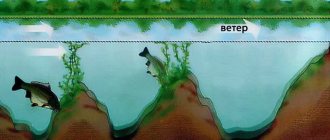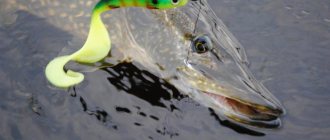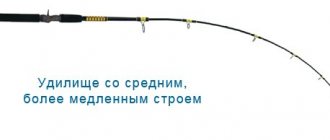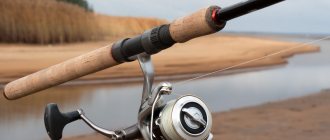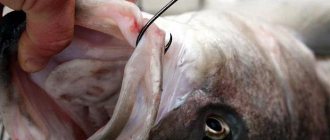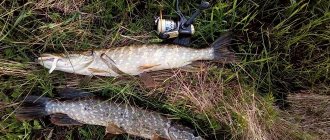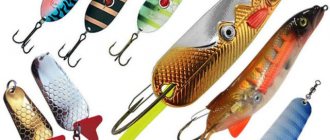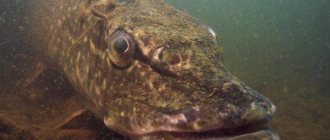Biting calendar
| January | February | March | April | May | June |
| — | — | + | +++ | +++ | +++ |
| July | August | September | October | November | December |
| + | +++ | +++ | +++ | + | — |
Seasonal Fishing Guides
| Before spawning, pike bite well both on live bait and on artificial baits using a spinning rod. After spawning, the fish gradually gains strength, and the bite turns into a glutton by the end of spring or beginning of summer. |
| In summer, pike is quite capricious, because the fish is provided with rich food. And the peak of the weak bite occurs in hot July. This month is the most difficult time to catch pike. |
| In the fall, a good bite occurs before freeze-up, when the predator stores up fat for the winter. Details about autumn pike on spinning rods. |
| In winter, the greatest activity is observed when the ice forms, as well as with the arrival of the spring thaw. |
Which spinning rod is best for catching pike?
Spinning rods are used for fishing ; they have different lengths and different action tests. For long casts, use heavy baits and select rods of the same test accordingly.
In shallow waters, light baits are used; in the grass, unhooked baits are better, and in the depths, jig baits are also used. Depending on the body of water and the weight of the bait, the optimal spinning test is selected.
There are no favorite baits for pike; for it it is an imitation of prey and how it behaves in the water. If the pike doesn’t grab your bait, it doesn’t matter (they sell it in the store), it may be worth changing it, perhaps the pike will be interested in another bait from your arsenal.
Experimentally, replacing baits increases the likelihood of catching pike.
The weather is also a factor for pike; it has been noticed that pike readily bite on cloudy days (autumn is the best time for pike). But even in summer, pike is no less appetizing than in the autumn.
What is the best way to catch pike?
Fishing will be interesting if the whole process is filmed with an underwater camera.
Joke.
A woman complains to a friend: “My husband and son went fishing for a week. One day in the apartment, the second... On the third, withdrawal symptoms began - there was no one to feed!!!”
Pike spawning
Pike is one of the first freshwater fish to spawn. The mating season begins at a water temperature of 3-5°C. Usually spawning occurs in March , but with changes in temperature it can be delayed or accelerated.
The spawning ground is located on the shallows, in thickets of reeds, sedges, and bushes. The depth does not exceed 2 m. Several males usually follow one female. To spawn, the fish actively uses any objects that can be rubbed against.
The breeding period can last from 2 to 4 weeks. During floods, many pike offspring often die.
Choosing the right gear
Devices for catching pike with a spinning rod in the summer are extremely important for the final result. The key component is the rod. Its length is selected based on fishing conditions. The average starting value varies from 6 to 40 g, and height from 2 to 2.5 m. A long rod can be chosen if long casts are planned, for example in wide bays or large reservoirs. The best material is high-modulus carbon.
The reel is a part on which it is strictly not recommended to skimp. For beginners, it is best to catch pike with a spinning rod in the summer using inertialess models, while experienced fishermen are better off using multipliers. The optimal spool size is from 2 to 2.5 thousand units according to the Shimano classification.
When choosing between fishing line and cord, 10 years ago they gave unconditional preference to fishing line, but today the situation has changed, and cord is in the lead. The small diameter and significant breaking load are ideal for spinning tackle. A medium-sized pike requires a section of 0.12 mm, and a large trophy requires a section of 0.16 mm.
The role of the leash in fishing is enormous, because Don’t forget, pike is a predatory fish and it has the sharpest teeth that can bite through almost any material and even steel. The preferred leader length is 0.1-0.3 m. More precise figures depend on the size of the fish.
In conclusion, I would like to add that pike fishing is a dynamic and exciting process. The most important thing is to analyze your actions and monitor the reaction of the fish. Only in this case, the result will not be long in coming, because fishing is not the easiest, but at the same time incredibly interesting hobby!
Habitats
Pike tolerate unfavorable oxygen conditions in the reservoir quite comfortably. Due to its endurance, it is distributed in all rivers, streams, lakes, reservoirs and ponds. Only in small, small closed ponds that freeze to the bottom in winter is the toothy fish unable to survive.
Pike occupy certain water areas in rivers and lakes. If a larger predator leaves its territory, another weaker fish takes its place. Pike can live both in deep holes, whirlpools and riverbeds, and on shallows, in grass, in snags, near the shore.
Reeds, water lilies, thickets are the habitats of pike
The best lures and baits
The choice largely depends on the time of year and conditions. Let's look at different options. Pike almost always willingly take the bait. Perch, roach, bleak, gudgeon and other small fish, preferably live, are suitable as live bait. The predator is not very fond of the dead fish and bites on it reluctantly. It is better to hook it behind the back, under the fin, carefully so as not to damage the spine, but so that the tee (double) penetrates the muscles and does not stick to one skin. The rest of the treat offered by the fisherman consists mainly of spoons and other imitators of live prey: frogs, mice and various fish. Don’t forget about twisters and other types of silicone baits; an experienced fisherman has quite a large number of them.
Pike readily takes red baits, but in cloudy weather it can switch to light ones - yellow, white. They should also vary in size - today medium ones will help, and in the next days small ones will help.
To learn more:
Fishing bow: crime and punishment
Finding a pike fishing spot
Pike loves to hunt from ambush. Therefore, it is necessary to look for the toothy predator in places where it can hide.
These can be any bottom irregularities, depth changes, or edges. Pike is perfectly camouflaged in aquatic vegetation, so promising fishing spots will be the boundaries of clear water and grass thickets, windows in reeds, sedge, flooded bushes and snags.
Fallen trees, leaning bushes, bridges, and pillars also become shelters for predators.
It should be taken into account that the toothy one attacks prey that is located or swims in a higher horizon.
Features of pike fishing
Pike fishing is not as easy as it seems. Not every angler manages to catch a large specimen.
When fishing, it is necessary to take into account certain features:
— the pike’s mouth is sharp, which easily damages the fishing line, so it is worth using the most reliable gear when fishing;
- wounds from fish teeth can be dangerous, they hurt for a long time and do not heal, which requires caution;
— when fishing in the summer, it is necessary to use a reliable landing net, which helps to remove fish from the water;
— pike loves places where you can set up an ambush using snags and natural bottom irregularities;
— in March, the fish spawn for 2-3 weeks, and during this period they eat practically nothing, but the next month after spawning is considered the most successful for fishing in the spring.
Each angler has his own secrets to success in pike fishing. But there are general rules that arose from the experiences of other people. It's worth listening to them. It is believed that the best live bait for pike is crucian carp. It is found everywhere in water bodies and does not cause suspicion among predators.
Techniques for catching pike with a spinning rod in summer
The technique of catching pike using a spinning rod varies. It is best for novice fishermen to use a uniform and slow retrieve.
You can also fish for pike using a stepped retrieve or a twin-jig retrieve. During a stepped retrieve, the pike catches the bait as it falls, but a twin-jig retrieve can be characterized by twitching of the rod.
When choosing a fishing technique, you also need to pay attention to the water temperature, since pike are not active in the summer heat. Therefore, before choosing a fishing technique, you need to pay attention to weather conditions.
Pike food
Starting from the first days of its life, pike leads a pronounced predatory lifestyle. More than once you can see how a small bee-eater holds a fish in its teeth that it is not able to swallow.
The older the pike, the larger the fish it grabs. However, if there is a lack of food, it is capable of destroying frogs, worms, crayfish, shells, leeches, and also engaging in cannibalism.
Spiny fish species (ruff and perch) also become a delicacy for pike. Even fishermen's vegetable baits sometimes stimulate the fish's appetite.
Pike attacks a disproportionately large target
Predator feeding and spawning
Any small living creature that finds itself in the predator’s field of vision can become its prey: perch, roach, minnows, ruffs and other fish. On occasion, he does not refuse small bream, silver bream, ide, small pike. More than once, villagers noticed that large predators attacked birds and small animals living in the water. Ducklings, mice, frogs, and muskrats can become targets of attack. There are no restrictions for her - she will happily feast on any living creature that is smaller in size.
To learn more:
How to use a knotter to make flies: step-by-step instructions
Pike spawning begins soon after the final ice melts, when the water warms up a little. Early spawning is observed in small pikes; large specimens spawn several days or weeks later. Females begin to throw at the age of four, and sometimes three years, males mature a little longer. A shallow place is chosen as a spawning ground - 50-100 cm, where the water warms up faster, which means that the fish will be more active. Here the female lays eggs and the partners fertilize them.
One pike per season can spawn from 20 to 200 thousand eggs - the specific number depends on age and size. Large (up to 3 millimeters in diameter) fertilized eggs have a slightly sticky surface, making them easily stick to objects. But after a few days, the stickiness decreases and they fall to the bottom, where they subsequently grow. The process goes through several stages:
- the egg is not active, develops due to the supply of nutrients;
- The larva hardly moves. It receives everything it needs for life from the yolk sac attached to the stomach;
- The fry swims confidently, feeds on the smallest organisms, gradually turning into an adult.
During spawning, the predator develops a strong hunger, but fishing is not allowed - fishing is poaching and is strictly punishable by law.
Fishing methods
In open water from the shore and from a boat
Analytical article-review of all possible gear for catching toothy predators.
Spinning fishing (all lures) - a guide to all popular types of artificial baits for catching even the most cunning pike.
Spinning fishing with spoons is one of the most common methods of catching pike among both adult and younger generations of anglers. Another guide to choosing catchable pike lures.
For wobblers - how to properly use artificial baits for surface and deep water fishing in search of pike. Two reviews of the best wobblers and killer wobblers.
Fishing with live bait - all gear and fishing techniques associated with live bait hunting for pike on the water in spring and summer.
Mugs are one of the types of live bait gear used when fishing in open water.
When is the best time to catch pike in summer?
In the summer, usually between the 10th and 15th of June, the ban on fishing (spawning) ends; after spawning, the pike is weak and hungry, it needs to gain strength and it greedily grabs everything ( spinners, spinners, wobblers , etc.), as they perfectly imitate a fish ( wounded or sick ).
Pike bites in summer can occur all day long, even though you can catch pike all day in sparse reeds , which is a joy for the angler.
